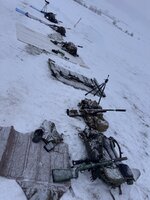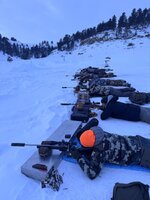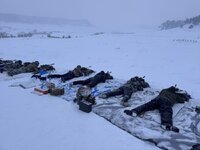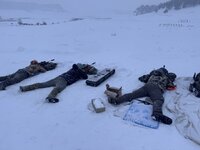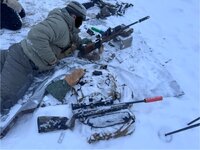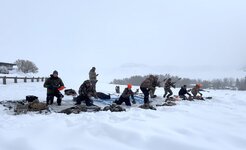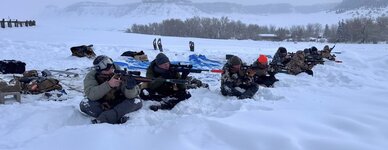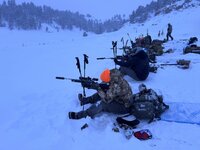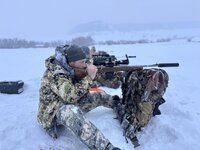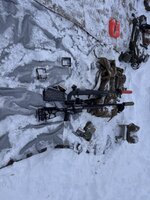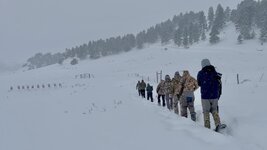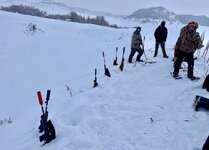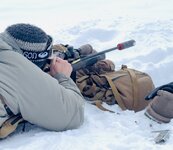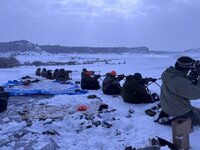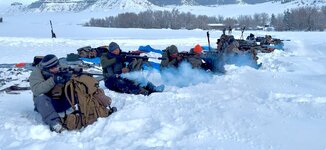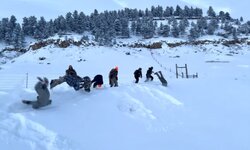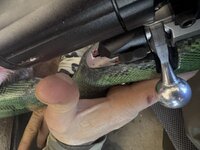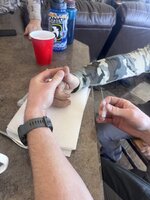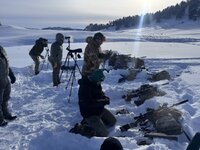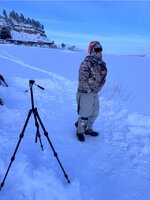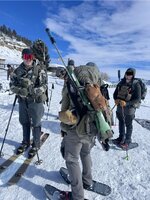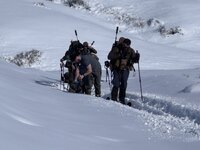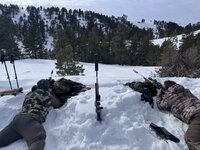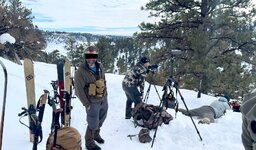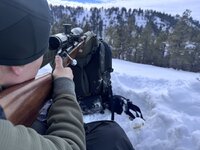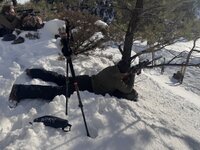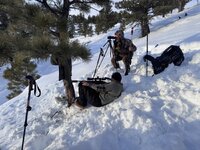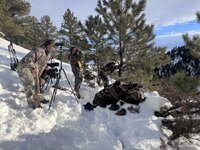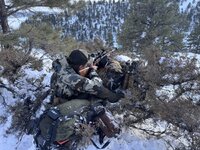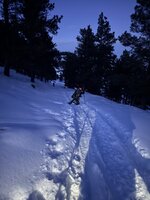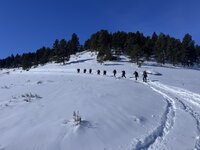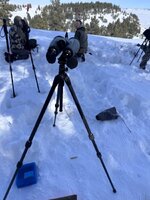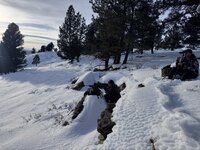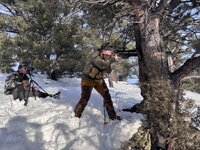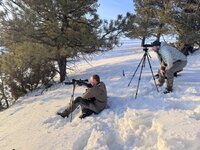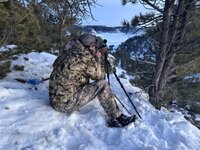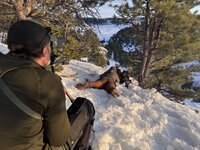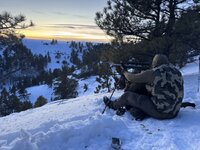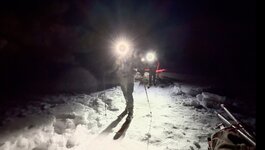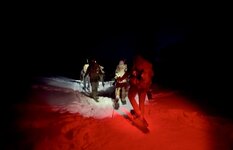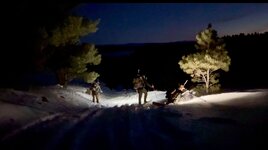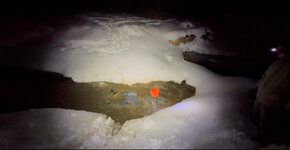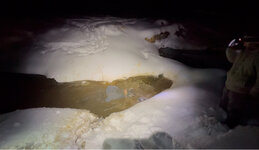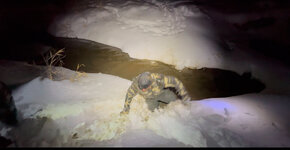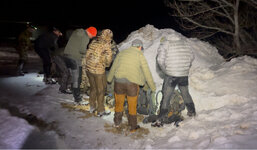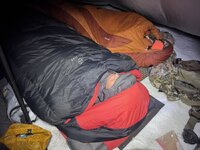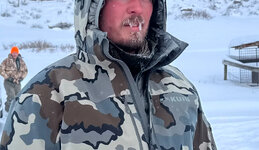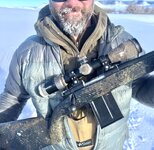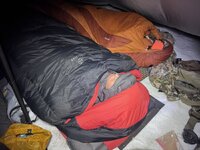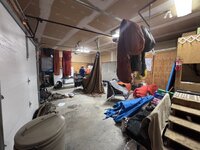Hard Gear:
Packs:
Packs used were Kuiu, Stone Glacier, Exo K4’s, and a hiking bag. Most are/were too strappy, and all lacked the ability to access required insulation/gear without undoing the straps, buckles, and the bag itself. Bag yard sales were common each day. It was either that, or they looked and sounded like Samwise Gamgee- crap strapped all over their bags clanging and clattering each step they took.
Having to undue multiple straps, open the main bag up, undue buckles, etc to reach puff suits, tripods, spotters/binos, etc. is just silly and sucks as a user. There were two bags present that were/are specifically designed for winter backpack hunting- half the buckles of most packs, and not one buckle or strap has to be undone to access what is required for the day. By far they were the cleanest and most elegant solution present.
Skis and snowshoes:
The snow depth was 3-4 feet most places for most of the week. Snowshoeing was not a problem for anyone that I saw. The skis however were a different matter. Going up, and breaking trail didn’t present issues that I saw or heard, but going down was a learning experience for most. The skis used were Altai Hok’s and Taos. They break trail much better than snowshoes, can cover ground mush faster with less exhaustion- but they do not cut like downhill skis. A couple of people had down enough with them that down hill wasn’t a major issue, however others- even experienced downhill skiers were not so great. Several chose to pull them off and walk downhill back to the house on the last day with the wet, packed down snow after basically not being able to stay upright on them.
Rifles:
Mostly Tikka T3’s. 4x Remington based rifles/actions (2x Bat, 2x Remington), 1x Tikka M595, and 2x MRC prototype Marshalls.
The first day it was single digits and snowing. One BAT action/custom had a failure to feed on round number 2, and a failure to eject in round number 18.
After that, I had everyone leave their actions open and facing up/exposed to the snow to see what would happen with the Tikka’s. The actions would be totally filled with snow by the time we pasted targets and came back. One user just inserted a mag in a Tikka and closed the bolt with a snow filled action- this caused it to make the snow into ice in the chamber, and the bolt had to be hammered down with a fist to close. It closed and functioned fine after that. Everyone else that saw just tipped the rifle over dumping most of the snow out and had no issues.
On day 2 or 3, a Remington trigger was completely dead and would not fire on the first round- it started working IIRC on round 4. A Bixn Andy had 2x light strikes right off then started working. No Tikka triggers had issues due to snow or ice. 2x Waters Rifleman 2.6” COAL mags had a round nosedive into the front of the mag- Waters warns about this with the 2.6” mags and standard loaded length rounds.
The MRC’s were left open and exposed everyday, all day in continues light to mid falling snow to see what would cause them to fail- nothing did for 5 days. They functioned and fed perfectly from first round to last, with no issues despite having the most exposure to weather of any rifles. On day 5 at -15° F, the 308 MRC would not release the firing pin. The firing pin was removed on the spot (its extremely easy to field strip) and it was found that there was grease on the firing pin and spring that had frozen to the point it was hard dust and caked everywhere. The user knocked it off, wiped it, reassembled the bolt, and the rifle functioned perfectly thereafter. That night he degreased the bolt and had zero issues for the rest of the course.
A Tikka triggers had a lighter trigger spring in it, and on day 6 it had a slam fire when closed in the user. In about 20 hard bolt racks I got it to release one time afterwards. This continues the 100% failure rate of Tikka triggers with replaced lighter springs that I have seen used heavily. Back off the spring screw as the factory designed them, and
LEAVE THEM ALONE. If you must remove the trigger for some reason, degrease everything, use a nail polish or a lot of paint from a paint pen, and torque it back on
TIGHT.
On day 7 one user had a custom 6.5 PRC R700 and a borrowed suppressor that had a carbon chunk fall on the bolt face and stop the bolt lugs from turning when closing the action. In several thousand suppressors that I and my group have seen used for hundreds of thousands of rounds- this is the first time I have seen it with a centerfire rifle (have seen it with Vudoo .22’s).
I am aware in my circle of it happening a couple of times with others. Every single time it has been with “custom” barrels/chambers, and mostly with 6.5 PRC’s.
We also had one user with max book loaded 243win ammo that worked without issue, that when shot heavily in the snow started randomly blowing primers and with hard extraction. This is due to the snow melting from the heat, ammo getting wet when loading, etc and causing pressure issues.
Scopes/mounts:
1x Leupold (Mark 4 HD) was present, it lost zero and continually had vertical POI shifts. It in the field eval scope in the Eval sub forum.
1x SWFA fixed 10x fell/knocked over directly on its elevation turret on a concrete floor- it was a several foot drop. The turret bent at a 15’ish degree angle- you could see it from across the room immediately. It seemed like the whole elevation turret body was spinning as well. That night when taking it apart, it was the outer sleeve with index lines that came lose- that was glued back with Loctite 380, and the turret was bent back as straight as it could be with a hammer- not light strikes; it was hammered back into place. The next morning not only did the scope still work, it was still zeroed correctly.
After hammering and trying to get the dents out of the turret cap-
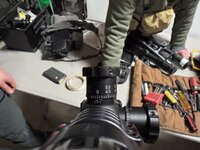
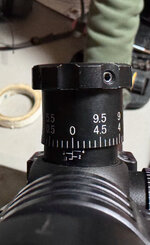 Spotting scopes and binos:
Spotting scopes and binos:
15x binoculars dominate in spotting shots for partners, way faster to get on target and easier to see trace/splash/impacts.
Most spotting scopes have extremely short eye relief (basically everyone but Leupold), and they cause no end of issues for people to spot with- especially under stress and time constraints. Having to shove an eyepiece through your eye socket to get a full FOV is ridiculous in all cases, and when needing to be quick or in dynamic situations, it makes finding targets/animals and spotting shots impossible at times. They’re so bad, that several people just stopped using them all together and just used 10x binos clipped into tripods to spot. That in note answer- 15x binos or a spotter with correct eye relief is.
The Leupold Mark 4 12-40x spotter has no such issue- it is still probably the best overall field spotter on the market.
Shooting bags:
Hard rear bags, and bags with nearly full fill cause all kinds of issues. Rear bags should be half filled, sloppy, formless masses that allow the person to control the rifle. There is a reason the Jellyfish rear bag is designed the way it is.
Overall thoughts:
The winter training environment is like no other. It reveals flaws and failures in people and equipment like few environments can. When done correctly it can be, and is very fun to be in. This was a fun class with fun people that maintained a good attitude that whole time.
We will change how we do the snowshoe and skiing familiarization if we do another winter course, so that everyone is comfortable with the skis when we start going into terrain.
We had one ND when the user was going fast (completely safe)-
trigger finger straight and safety on must be a conditioned, subconscious action that is done every single time without fail.
Never should someone’s index finger close up in the rifle when not firing. This is not an uncommon occurrence with people, and it almost always happens to people who do not use the safety religiously.
I will continue to say it-
DO NOT GET CUTE WITH YOUR LOADS OR CHAMBERS. Benchrest and range guns, PRS toy rifles, etc. it doesn’t really matter. Rifles and guns meant to be used in the field, that
must work-
do not do dumb shit. Good rifles, using factory ammo in factory chambers just work without issue. Nearly 100% of problems that we see are from “custom” actions, triggers, barrels, chambers, and hand loaded “for precision”ammo.
People can’t hit 3 MOA targets on demand with a little bit of stress, their rifles and scopes lose zero constantly, they flinch like a mother, etc, etc; your “5/1000ths closer to lands bullet that increase precision by .0007”, isn’t making a bit of difference.
Gear and equipment that work without fail, that are simple and reliable shine in field environments- not complicated and over engineered nonsense.
